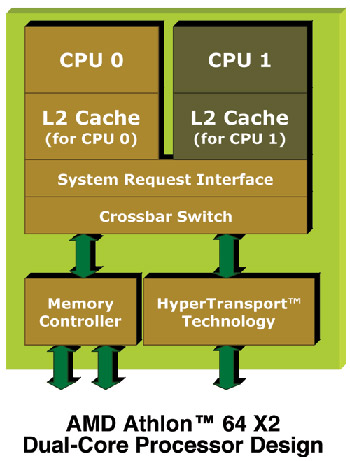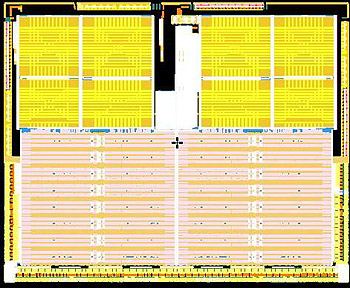 The current form factor of the Athlon 64 processor is very conducive to a
dual core design. The fact that the memory controller and hypertransport
links are built right into the die of the chip means that supporting a second
full processor core is no huge logistical feat either for making the die of the
chip or the motherboards it will operate in. This is not the biggest
advantage that the Athlon 64 architecture has for dual operation though.
The current form factor of the Athlon 64 processor is very conducive to a
dual core design. The fact that the memory controller and hypertransport
links are built right into the die of the chip means that supporting a second
full processor core is no huge logistical feat either for making the die of the
chip or the motherboards it will operate in. This is not the biggest
advantage that the Athlon 64 architecture has for dual operation though.
Due to
the Northbridge-like provisions that AMD had to add to the Athlon 64
die in order to support the onboard memory controller and hypertransport
link, it is possible for the dual cores to communicate
with each other inside the processor itself.
While this might seem like an obvious thing, Intel dual-core
processors cannot do this at all (currently). Intel's solution must relay all
information over the external 'frontside bus' link that connects the
processor to the rest of the system.
AMD dual-core Athlon64 X2 processorss more than double the
transistor count of previous Athlon 64 processors. The Athlon 64 X2 4800+
chip sports 233million transistors as opposed to the 106 million or so of the
Athlon 64 FX-55.
Since the new dual-core chips use the 90nm fabrication method though, overall
chip size has just barely increased. Operating voltage will be 1.35 to
1.4V and heat output will be just slightly increased over the high-end Athlon FX
processors at 110W.
Each processor core has its own L1 and L2 cache memory, 128KB for L1, and between
512KB and 1MB of L2, depending on the specific model.
 On paper, it really appears that
AMD has done its homework. More than that, its engineers appear to have done it months
ago when the company first introduced the 64-bit Opteron processor.
On paper, it really appears that
AMD has done its homework. More than that, its engineers appear to have done it months
ago when the company first introduced the 64-bit Opteron processor.
The "crossbar switch" that accumulates and distributes
address and data transfers from each core to the other core and the rest of the
system already had an available connection for a second core.
Where AMD scores major
points for paying attention to its user base is with the fact that the first
run of dual-core Athlon 64 X2 chips will be compatible with
any current Socket 939/940 motherboard, provided the manufacturer updates the BIOS to support the
new feature.
Given the havoc that the company
wreaked on its users and its bottom line by shifting to Socket 939 so early in
the life of the Athlon 64, essentially orphaning Socket 754, this is the kind of
good PR that AMD really needs. Here's hoping this is a return to the glory
days of Socket A and the huge range of processors that that platform ended up
supporting. Selling a dual-core desktop processor as a direct upgrade will
be a lot easier than trying to persuade home users to update their motherboards...
yet again.
